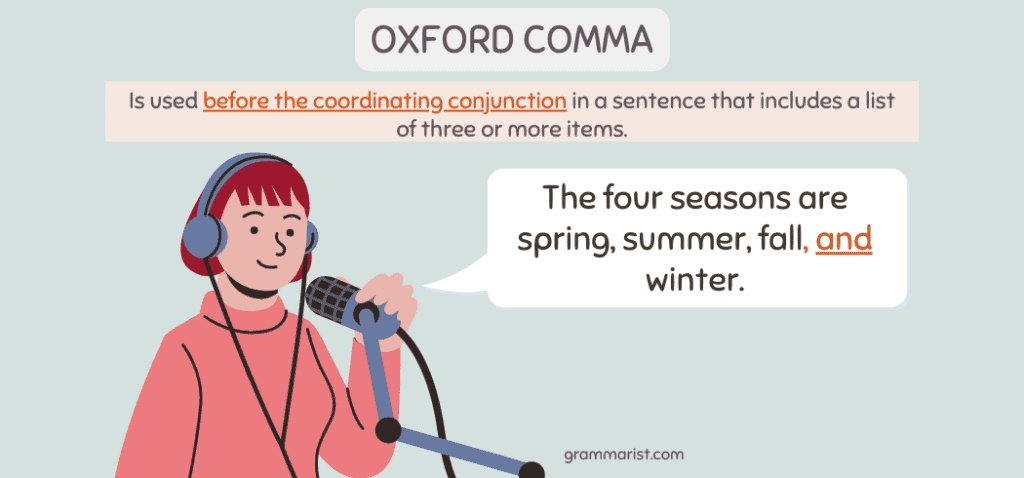Have you ever read a sentence and wondered if it was missing a comma—or clarity? That’s where the Oxford comma comes into play. Though it may seem like a minor punctuation mark, it can significantly impact how we understand written language. But what exactly is the Oxford comma, and why is there so much debate around it? Let’s explore.
What Is the Oxford Comma?
The Oxford comma, also known as the serial comma, is the comma placed immediately before the conjunction (usually and or or) in a list of three or more items. For example:
- I love reading, writing, and editing.
Here, the Oxford comma appears after writing.
Without it, the sentence would read:
- I love reading, writing and editing.
This might not seem problematic until you encounter more complex sentences where clarity is essential.
The Argument for the Oxford Comma
Advocates of the Oxford comma argue that it adds clarity and avoids ambiguity. This is particularly important in legal documents, journalism, academic writing, and professional communication. A well-known example often cited in the Oxford comma debate is:
- I dedicate this book to my parents, Oprah Winfrey and God.
Without the Oxford comma, it humorously suggests Oprah and God are the writer’s parents.
Using the Oxford comma clarifies the intent:
- I dedicate this book to my parents, Oprah Winfrey, and God.
Now it’s clear the author is listing three separate entities.
Common Situations Where the Oxford Comma Matters
1. Legal Writing
In legal and contractual documents, ambiguity can lead to lawsuits. One real-world case involved a dairy company in Maine, where drivers sued over the interpretation of a statute that lacked an Oxford comma. The court ruled in favor of the drivers, costing the company millions in overtime pay.
2. Academic and Technical Writing
In research, textbooks, and technical writing, where precision is crucial, the Oxford comma helps prevent misinterpretation.
3. Professional Emails and Reports
Business communication often benefits from consistent and clear punctuation. Including the Oxford comma in lists improves professionalism and readability.
The Case Against the Oxford Comma
Despite its advantages, many style guides—especially in journalism—omit the Oxford comma. Publications like The Associated Press Stylebook argue that it’s unnecessary unless the sentence would otherwise be unclear.
Opponents also cite these reasons:
- Visual clutter: Some believe it interrupts the flow of reading.
- Brevity: In fields like journalism, space-saving is key.
- Consistency with spoken language: We don’t usually pause before the final item in a list when speaking.
Ultimately, those who skip the Oxford comma rely on sentence structure to maintain clarity.
Style Guide Preferences
Whether you use the Oxford comma often depends on the style guide you follow. Here’s how some major guides view it:
- Chicago Manual of Style: Strongly recommends using the Oxford comma.
- Oxford University Press: Requires the Oxford comma—hence the name.
- Associated Press (AP) Stylebook: Avoids the Oxford comma unless needed for clarity.
- Modern Language Association (MLA) and APA Style: Favor the Oxford comma.
Writers should always follow the preferred style of their organization, publication, or academic institution.
When to Use It and When to Skip It
While there’s no universal rule, a good rule of thumb is:
- Use it when clarity could be compromised.
- Skip it only when you’re confident the meaning is clear without it and your style guide permits omission.
Oxford Comma Examples: Clarity in Action
With Oxford Comma:
- She brought cupcakes, juice, and cookies. (Three distinct items)
Without Oxford Comma:
- She brought cupcakes, juice and cookies. (Could suggest juice and cookies are one item)
Another example:
- The flag is red, white, and blue. (Clear separation of colors)
Versus:
- The flag is red, white and blue. (Could be misinterpreted as a combination of white and blue)
Why Consistency Is Key
Whether you love it or leave it, being consistent is more important than choosing a side. Inconsistent punctuation distracts readers and diminishes your credibility as a writer. Pick a rule—and stick to it throughout your content.
Conclusion:
Whether you’re a student, a legal writer, or a content creator, understanding the Oxford comma is essential for clear communication. While its use may depend on your audience or the style guide you follow, its role in preventing confusion is undeniable. If clarity and precision are priorities in your writing, including the Oxford comma is a smart and safe choice.
Frequently Asked Questions (FAQ)
Is the Oxford comma grammatically required?
No, it’s a stylistic choice. Some grammar authorities endorse it, while others do not.
Why is it called the Oxford comma?
Because it was traditionally used by editors at Oxford University Press.
Does omitting the Oxford comma change the meaning of a sentence?
It can. In certain cases, the lack of a comma creates confusion or changes the perceived relationships between list items.
Which countries use the Oxford comma more?
The Oxford comma is more common in American English. British English tends to omit it unless needed for clarity.
Can I use the Oxford comma in informal writing?
Absolutely. Many writers use it in emails, blogs, and social media posts to avoid confusion and maintain a clean, professional tone.

